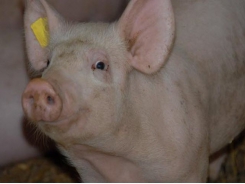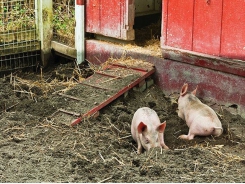Salmonella control: Do organic acids solve the problem?

Using effective organic acid products under the right conditions can reduce the presence of Salmonella and improve the productivity of our herds.
Organic acids are one of the strategies offered to control and reduce Salmonella levels on the farm.
Salmonella is the main zoonotic agent transmitted from contaminated pork to humans. Except in infections caused by Salmonella Cholerasuis (the host-adapted serotype to pigs able to cause a severe and, on occasions, fatal disease), non-Typhoidal Salmonella serotypes usually cause a subclinical disease, and only a few, such as Salmonella Typhimurium, are able to cause diarrhea, which rarely progresses to a fatal disease. That is why its control is addressed as a food safety issue.
On-farm control success is limited by the complex epidemiology and the lack of any particular effective interventions. Organic acids are popular among on-farm alternatives to control Salmonella. Their efficacy is affected by factors such as the acid and the concentration chosen or the duration of the treatment.
The challenge of the on-farm control
- On-farm control of the pathogen is addressed as a food safety issue rather than swine disease. There are a number of factors that reduce the success in the on-farm control of the pathogen:
- Non-evident clinical signs, a fact which reduces the interest of producers to tackle a problem that, in many occasions, is not palpable.
- The lack of particular strategies, which, on their own, are able to clear Salmonella from infected pigs and remove the pathogen from herd environment.
The complex epidemiology of the pathogen, which limits the efficacy of any control intervention applied.

The complex epidemiology of the pathogen limits the efficacy of any control intervention applied.
A control measure that can reduce Salmonella — or not?
On-farm control of Salmonella can include different strategies. The use of organic acids, either in feed or water, is one of the most popular. Short-chain (for instance, butyric or propionic) and middle-chain (caproic or caprilic) organic acids and other organic acids such as lactic or formic acid are able to improve gut health by their antibacterial activity against pathogens such as Salmonella. They also improve the conditions for beneficial microbiota (lactic-acid bacteria), which competes directly for the intestinal niche with the pathogen.

Control strategies can be applied at different stages. Hygiene and biosecurity measures are of paramount importance in all stages, while control strategies in feed or vaccination can be applied to reduce on-farm levels. Antibiotherapy is not recommended, as it is not effective against multi-resistant Salmonella strains.
Different studies have tried to assess the efficacy of the use of organic acids to control Salmonella with a disparity of results. In some studies, the use of organic acids was able to reduce Salmonella prevalence, while in some others, the intervention failed. Why do we have these divergences in effectiveness? Are organic acids thus useful to the control of Salmonella? The answer is yes, but under certain conditions.
Factors that affect the efficacy of organic acids against Salmonella:
- Acid used: Not all the acids have the same effect. Research studies highlight that butyric, propionic or formic acid effectively reduce Salmonella levels while the same or other studies point out that other acids, principally acetic acid, have no beneficial effect against Salmonella.
- Presentation: Commercial products usually encapsulate the acid or mix of acids included in the formulation. Some of these products also include other compounds, such as essential oils, other antimicrobials, etc. The inclusion of these compounds and the encapsulation may boost the effect of the product.
- Concentration: Concentration used is one of the key factors. The higher the concentration, the better the results. For instance, a study combining formic-propionic acids was effective reducing Salmonella shedding in feed when the product was used at 1.2 percent, but not when it was administered at 0.8 percent. The limitation of using higher concentrations is that cost is increased and the intervention could not be feasible from an economic point of view.
- Treatment duration: Treatment duration is the other key factor. The right combination duration-concentration will determine the success or failure of the intervention. In general, short treatment periods (between 2 weeks and 4 weeks) have yielded poor results. Studies using propionic, formic, butyric or a mix of acids at a concentration between 0.3 percent and 2 percent for prolonged periods (between 6 and 12 weeks) could decrease the percentage of pigs shedding Salmonella in feces.
Salmonella serotype: In contrast to vaccines, the effect of organic acids is not serotype-dependent.

In some studies, the use of organic acids was able to reduce Salmonella prevalence, while in some others, the intervention failed.
Cost-benefit analysis of use of organic acids
First of all, it must be noted that despite the infection in most of occasions subclinical, there is a lower performance of infected pigs compared to Salmonella-free pigs. For instance, in a study in grower pigs, feed conversion efficiency (Kg/Kg) (FCE) was 1.88 and 1.66 in Salmonella-infected and Salmonella-free animals, respectively. Cost-benefit analysis in different commercial products revealed interesting data. Using these products at the recommended rates, FCE was improved in pigs with the acid diet compared to the control diet, together with a better cost of feed per Kg of live weight gain (EUR0.89 in the control feed and EUR0.84 in the feed supplemented with the acid).
Organic acids as a strategy
Organic acids are one of the strategies offered to control and reduce Salmonella levels on the farm. The market offers lots of products with different combinations of organic acids, which makes a particular choice difficult. The right dose and treatment duration are essential for success, but acids need other on-farm interventions related to hygiene, biosecurity and management to reduce Salmonella to negligible levels..
Related news
Tools

Phối trộn thức ăn chăn nuôi

Pha dung dịch thủy canh

Định mức cho tôm ăn

Phối trộn phân bón NPK

Xác định tỷ lệ tôm sống

Chuyển đổi đơn vị phân bón

Xác định công suất sục khí

Chuyển đổi đơn vị tôm

Tính diện tích nhà kính

Tính thể tích ao




 Methionine beyond protein synthesis in growing pigs
Methionine beyond protein synthesis in growing pigs  How lactic fermented pig feeds benefit swine production
How lactic fermented pig feeds benefit swine production